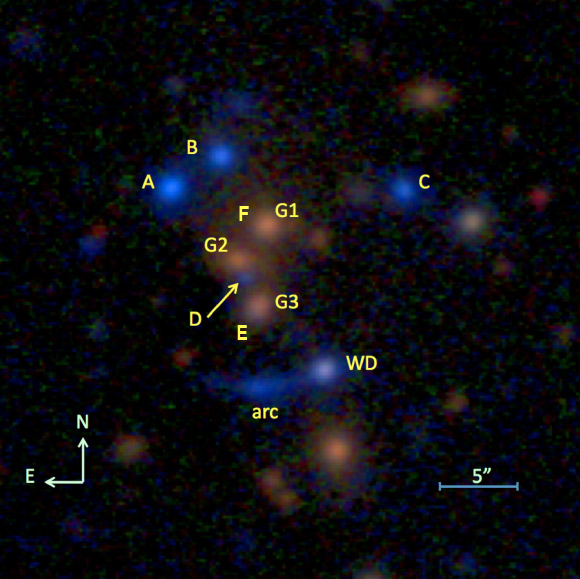A team of scientists at the University of Copenhagen’s Niels Bohr Institute, Denmark, has reported the discovery of a six-image lensed quasar named SDSSJ 2222 + 2745.

This photo shows the six-image lensed quasar SDSSJ 2222 + 2745: A – F are quasar images; G1, G2 and G3 are members of the lensing galaxy cluster; WD is a candidate quasar image (Dahle H. et al).
“This is the first time that a quasar has been observed whose light was reflected or ‘lensed’ in six separate images,” explained Prof Johan Fynbo, who is a senior author of a paper published in the Astrophysical Journal (preprint at arXiv.org).
Quasars are very energetic and distant active galactic nuclei that radiate as much energy per second as a thousand or more galaxies. They are intense sources of visible light as well as X-rays. Some quasars are so bright that they can be seen at a distance of about 12 billion light years.
The newly discovered quasar SDSSJ 2222 + 2745 is located at a distance of more than 11 billion light years from our planet.
Niels Bohr astronomers discovered SDSSJ 2222 + 2745 in the course of the Sloan Giant Arcs Survey, in which they identify candidate lenses in the Sloan Digital Sky Survey and target these for follow up and verification with the 2.56-m Nordic Optical Telescope.
SDSSJ 2222 + 2745 is the third-known lensing system where a quasar is being multiply lensed by a galaxy cluster.
“This is only the third known case of a quasar lensed by a cluster, and the only one with six images,” the scientists said.
“This galaxy cluster has so much gravity that it pulls the light from the quasar. So instead of radiating in straight lines from the quasar, the light is deflected in an arc around the galaxy cluster,” Prof Fynbo added.
“In this way, one can observe not just one, but several images of the same quasar. This is called the gravitational lens effect.”
According to the team, the predicted time delays between different pairs of quasar images range from about 100 days up to 6 years.
______
Bibliographic information: Dahle H. et al. 2013. SDSS J2222+2745: A Gravitationally Lensed Sextuple Quasar with a Maximum Image Separation of 15.”1 Discovered in the Sloan Giant Arcs Survey. ApJ 773, 146; doi: 10.1088/0004-637X/773/2/146







